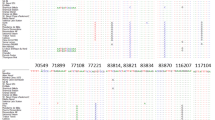Summary
A physical plastome map was constructed for Citrus aurantium, and the plastomes of species and cultivars of Citrus and of two Citrus relatives were analysed by Southern blot-hybridisation of labelled total tobacco cpDNA to digests of total Citrus DNA. A resemblance was found between the plastomes of cultivars of C. limon (lemon), C. sinensis (orange), C. aurantium (sour orange), C. paradisii (grapefruit) and C. grandis (pomello). The plastomes of other Citrus types such as mandarin (C. reticulata) and citron (C. medico) differed from each other as well as from the plastomes of the aforementioned group. The plastomes of Poncirus trifoliata and Microcitrus sp. are distinct from each other as well as from the Citrus types.
Similar content being viewed by others
References
Barret MC, Rhodes AM (1976) A numerical taxonomic study of affinity relationships in cultivated Citrus and its close relatives. Syst Bot 1:105–136
Ben-Hayyim G, Shani A, Vardi A (1982) Evaluation of isozyme systems in Citrus to facilitate identification of fusion products. Theor Appl Genet 64:1–5
Berthou F, Mathieu C, Vedel F (1983) Chloroplast and mitochondrial DNA variation as indication of phylogenetic relationships in the genus Coffee L. Theor Appl Genet 65:77–84
Bisaro D, Siegel A (1980) Sequence homology between chloroplast DNAs from several higher plants. Plant Physiol 65:234–237
Bohnert MJ, Loffelharht W (1982) Cyanelle DNA from Cyanophora paradoxa exist in two forms due to intramolecular recombination. FEBS Lett 150:403–406
Dyer TA (1984) The chloroplast genome: its nature and role in development. In: Baker NR, Barber B (eds) Chloroplast biogenesis. Elsevier Amsterdam, pp 30–69
Fluhr R (1983) Molecular genetics of the Nicotiana tabacum chloroplast. PhD Thesis Weizmann Institute of Science, Rehovot
Fluhr R, Aviv D, Edelman M, Galun E (1983) Cybrids containing mixed and sorted-out chloroplasts following interspecific somatic fusions in Nicotiana. Theor Appl Genet 65:289–294
Frankel R, Scowcroft WR, Whitfeld PR (1979) Chloroplast DNA variation in isonuclear male-sterile lines of Nicotiana. Mol Gen Genet 169:129–135
Galun E, Aviv D (1986) Organelle transfer. In: Weissbach A, Weissbach H (eds) Methods in enzymology, vol 118. Academic Press, New York, pp 595–611
Maniatis T, Fritsch EF, Sambrook J (1982) Molecular cloning. Cold Spring Harbor NY, pp 100–112
McIntosh L, Poulsen C, Bogorad L (1980) Chloroplast gene sequence for the large subunit of ribulose bisphosphate carboxylase of maize. Nature 288:556–560
Miami T, Kishima Y, Sugiura M, Kinoshita T (1984) Chloroplast DNA diversity in the cytoplasms of sugar beet and its related species. Plant Sci Lett 231–235
Palmer JD (1983) Chloroplast DNA exist in two orientations. Nature 301:92–93
Palmer JD, Thompson WF (1981) Rearrangements in the chloroplast genomes of mung bean and pea. Proc Natl Acad Sci USA 78:5533–5537
Palmer JD, Singh GP, Pillay DTN (1983) Structure and sequence evolution of three legume chloroplast DNAs. Mol Gen Genet 190:13–19
Palmer JD, Zamir D (1982) Chloroplast DNA evolution and phylogenetic relationships in Lycopersicon. Proc Natl Acad Sci USA 79:5006–5010
Perl-Treves R, Galun E (1985) The Cucumis plastome: physical map, intrageneric variation and phylogenetic relationships. Theor Appl Genet 71:417–429
Rhodes PR, Zhu YS, Kung SD (1981) Nicotiana chloroplast genome. 1. Chloroplast DNA diversity. Mol Gen Genet 182:106–111
Soost RK (1964) Self-incompatibility in Citrus grandis (Linn.) Osbeck. Proc Am Soc Hortic Sci 84:137–139
Stern DB, Lonsdale DM (1982) Mitochondrial and chloroplast genomes of maize have a 12-kilobase DNA sequence in common. Nature 299:698–702
Stern DB, Palmer JD (1984) Extensive and widespread homologies between mitochondrial DNA and chloroplast DNA in plants. Proc Natl Acad Sci USA 81:1946–1950
Swingle WT (1967) The botany of Citrus and its wild relatives. In: Reuther W, Webber MJ, Batchelor LD (eds) The Citrus industry. University of California, pp 190–430
Tanaka T (1969) Misunderstanding with regards Citrus classification and nomenclature. Bull Univ Osaka, Ser B 21:139–145
Timmis JN, Scott NS (1983) Sequence homology between spinach nuclear and chloroplast genomes. Nature 305:65–67
Vardi A, Spiegel-Roy P (1978) Taxonomy, breeding and genetics. Proc Int Soc Citricult 51–57
Vardi A, Spiegel-Roy P, Galun E (1982) Plant regeneration from Citrus protoplasts: variability in methodological requirements among cultivars and species. Theor Appl Genet 62:171–176
Wahl GM, Stern M, Stark GR (1979) Efficient transfer of large DNA fragments from agarose gels to diazobenzylomethylpaper and rapid hybridization using dextran sulphate. Proc Natl Acad Sci USA 79:2264–2267
Author information
Authors and Affiliations
Additional information
Communicated by R. Hagemann
Rights and permissions
About this article
Cite this article
Green, R.M., Vardi, A. & Galun, E. The plastome of Citrus. Physical map, variation among Citrus cultivars and species and comparison with related genera. Theoret. Appl. Genetics 72, 170–177 (1986). https://doi.org/10.1007/BF00266989
Received:
Accepted:
Issue Date:
DOI: https://doi.org/10.1007/BF00266989




